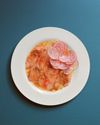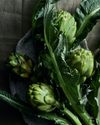The history of Middle Eastern food in this country is a history of people, movement and spices smuggled in suitcases.

When Ibrahim Kasif’s grandparents arrived in Sydney from Cyprus in the 1950s, they had to buy their olive oil from pharmacies. Anglo-Saxons didn’t then see much use for it beyond treating ear ailments. “There was simply nowhere else that sold it.” Joseph Abboud’s parents shared similar stories. Once, they told him, family friends had the police arrive unexpectedly when they tried to bake pita in a wood-fired oven in the backyard. Sirens wailed as za’atar-dusted bread spiced the air.
Passed down between generations of Middle Eastern migrants, these stories of culinary deprivation lend a heroic quality to the recipes that survived. They speak of a time when taste could be treasonous and, for chefs like Kasif and Abboud who run three of the most innovative Middle Eastern restaurants in Australia today (Kasif with Stanbuli and Abboud with Rumi and Bar Saracen), they remind them of their debts. “We have the luxury of saying, ‘oh, you’re stuck in your ways’ to our parents,” muses Abboud. “That’s because they did the hard yards. They’re not stuck in the mould, in fact they broke the mould.”
The story of how Australian palates came to delight in braised lamb or the sweet scent of orange blossom is quite brief. “If you look at the Australian food scene, the history of Middle Eastern cuisine is only 50 or 60 years old,” explains Kasif, “yet words like falafel, tahini or shish are all part of the vocabulary now.”
Kasif’s choice of dishes is telling: although the Middle East encompasses many nations, its flavours mostly came to Australia with Turkish and Lebanese migrants. And before Anglo Australians could enjoy their food, the government needed to shift from a policy of assimilation to multiculturalism. Australia needed to be liberated from the tyranny of shepherd’s pie.
この記事は Gourmet Traveller の June 2018 版に掲載されています。
7 日間の Magzter GOLD 無料トライアルを開始して、何千もの厳選されたプレミアム ストーリー、9,000 以上の雑誌や新聞にアクセスしてください。
すでに購読者です ? サインイン
この記事は Gourmet Traveller の June 2018 版に掲載されています。
7 日間の Magzter GOLD 無料トライアルを開始して、何千もの厳選されたプレミアム ストーリー、9,000 以上の雑誌や新聞にアクセスしてください。
すでに購読者です? サインイン

From personal experience
Former Hope St Radio chef ELLIE BOUHADANA invites you to gather your loved ones and enjoy an evening of good food and laughter with recipes from her new cookbook, Ellie's Table.

Kimberley Moulton
Kylie Kwong celebrates the individuals helping to grow a stronger community. This month, we applaud the international curator and Yorta Yorta woman who is shining a light on First Peoples.

Tom Wallace
We share a drop with the head winemaker for Devil's Corner, Tamar Ridge and Pirie Sparkling, a master of cool-climate grapes.

Best in class
The top drops to keep an eye out for on wine lists (and why they're worth the splurge)

A taste of refuge
Fleeing war and persecution, Australia's new arrivals push our food culture forward. DANI VALENT explores the contributions of the country's refugee communities.

BE OUR GUEST
Inspired by the sense of place conjured by Europe's Michelin-star restaurants, local restaurateurs are expanding their hospitality remit to include accommodation

Barcelona BUZZ
A popular drawcard for digital nomads and expats alike, the Catalonian capital offers equal parts sophistication and fun. Here, DANI VALENT discovers the latest dining hotspots.

HEATHCOTE BOUND
MICHAEL HARDEN hits the road to explore regional Victoria's Heathcote, home to this year's Best Destination Dining and a host of other delights.

The art of...relishing restaurants
Does working in hospitality make someone a better or worse diner

HEART AND SOUL
Not a vegetable but rather a flower bud that rises on a thistle, the artichoke is a complex delight. Its rewards are hard won; first you must get past the armour of petals and remove the hairy choke. Those who step up are rewarded with sweet and savoury creaminess and the elusive flavour of spring. Many of the recipes here begin with the same Provençal braise. Others call on the nuttiness of artichokes in their raw form. The results make pasta lighter and chicken brighter or can be fried to become a vessel for bold flavours all of which capture the levity of the season.